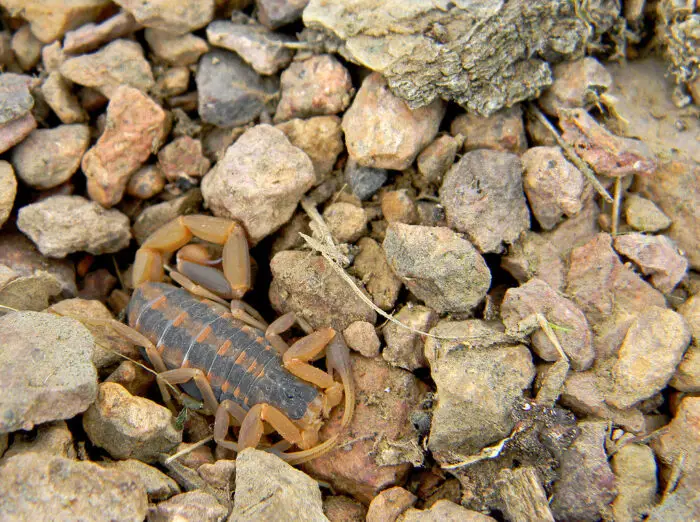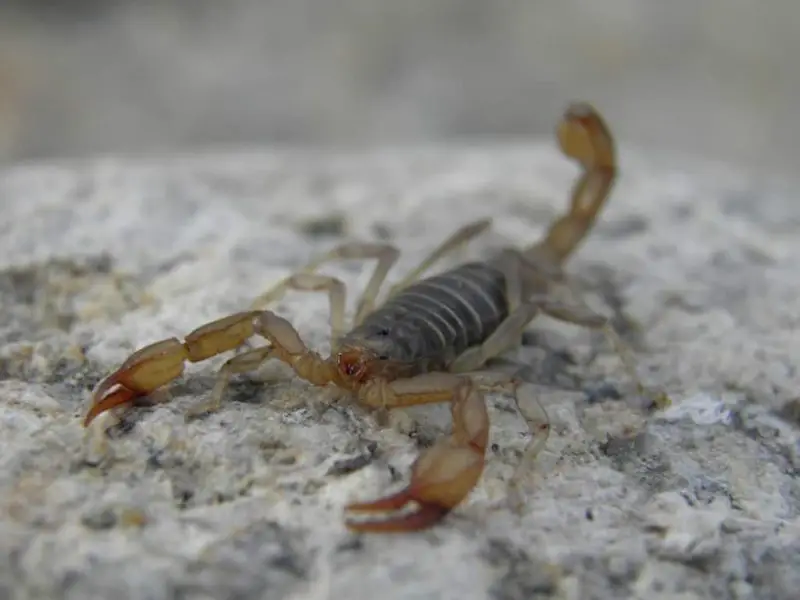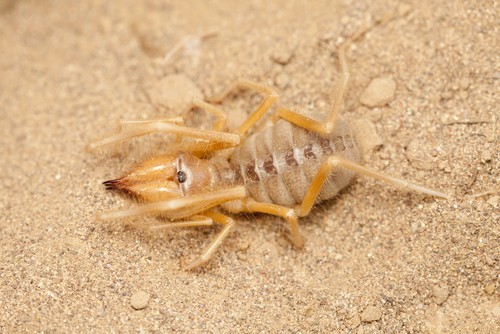Say the word scorpion, and it conjures up visions of the American desert southwest. That region of the country certainly does have its share of scorpions. However, there are many states outside of the desert southwest that also have scorpions. Nebraska is one of these.
Nebraska is home to the Striped Bark Scorpion (Centruroides vittatus) and the Northern Scorpion.
The two scorpions we’ll be talking about have stings that are no more medically significant than wasp stings. However, all scorpion stings have the potential to cause a severe allergic reaction such as anaphylactic shock. If you have blurred vision or difficulty breathing after experiencing a scorpion sting, seek immediate medical attention.
Nebraska is also home to a couple of scorpion-like arachnids. These are the pseudoscorpion and the wind scorpion. In the paragraphs below, we’ll talk about all three of these arachnid species.
Although these two species have scorpion in their common names, they are not true scorpions. We’ll talk about them anyway in the paragraphs below.

Common Striped Bark Scorpion (Centruroides vittatus)
Striped Bark Scorpions, which also go by the common names Plains Scorpion or Striped Scorpion, are Buthid Scorpions, just as the Arizona Bark Scorpion is. However, their sting is not nearly as dangerous as that of the Arizona Bark Scorpion. Common Striped Bark scorpions are the most common scorpions in the United States. Thousands of people are stung by them each year when they step on them with bare feet or come into accidental contact with them in some other manner.
Unlike Northern Scorpions and Northern Black Hairy Scorpions, which never venture far from their burrows, Striped Bark Scorpions are wandering hunters. Like all Bark Scorpions, they are natural climbers. Besides living under rocks, they climb trees and fence posts and have no problem climbing the walls of your home. They actually have a negative geotaxis, or in other words, they prefer an upside-down orientation. See
Striped Bark Scorpions live in a variety of environments, such as woodland, grassland, and desert. During the day, they will take shelter under rocks, beneath loose bark, or in wood piles, etcetera.
The range of the Striped Bark scorpion begins in the northern Mexico states of Chihuahua, Coahuila, Nuevo Leon, and Tamaulipas. It then extends northward up to the southern counties of Nebraska. Their range also extends longitudinally from the Sangre de Cristo mountains and Rio Grande of New Mexico in the west and the Missouri and Mississippi rivers in the east.
Adult Striped Bark Scorpions are up to 2 3/4″ long. An adult of this species is uniformly pale yellow in color, with the exception of two longitudinal dark stripes that run the length of its back and a dark triangle above its center eyes.

The Northern Scorpion (Paruroctonus boreus)
The Northern scorpion or Boreal scorpion is a species of scorpion in the family Vaejovidae.
Northern scorpions are found in 12 U.S. states and 3 Canadian provinces. The Northern scorpion species’ range begins in northern Arizona and goes north to southwestern Canada. In the United States, northern scorpions live in Arizona, California, Nevada, Utah, Idaho, Wyoming, Montana, North Dakota, South Dakota, Oregon, and Washington. In Canada, Northern Scorpions live in southern British Columbia, southern Alberta, and southern Saskatchewan. See
Northern scorpions are the most northern species of scorpion due to their ability to tolerate some cold. In fact, they are the only scorpion species to live in Canada.
In Nebraska, Northern scorpions inhabit the southwest corner of the state.
What do northern scorpions look like?
All scorpions look a little bit like tiny land-dwelling lobsters with some distinctions. Lobsters have 10 legs, while scorpions have 8, and of course, lobsters don’t have a bulbous venom-filled stinger on the end of their tail, while scorpions do.
Northern scorpions have segmented sections in their exoskeletons that range in color from light brown to dark brown. What’s more, they have a yellowish-colored, proportionately thin, long tail with a stinger on the tip and a lobster-like pair of pincers or pedipalps that do not function as legs. Instead, they use their pedipalps to capture and hold their prey. Northern scorpions are proportionately large-clawed scorpions.
A rule of thumb on claw size is that larger clawed scorpions have less powerful venom. They need their larger pincers to help them subdue prey.
Northern scorpions are relatively small scorpions. An adult northern scorpion will be 35mm to 55mm (1.37 to 2.16 inches) long. Northern scorpions display sexual dimorphism, with females being consistently larger than males. See
Northern scorpions are nocturnal creatures, meaning that they come out and are active at night. Inversely, they are mostly inactive during the day.
As most scorpions do, they have fluorescent compounds in their exoskeletons that make them glow under black light. If you are camping in an area where northern scorpions are active, it’s a good idea to go armed with an ultraviolet flashlight. Use the ultraviolet light to scan your campsite after dark, after 9:30 PM to be exact.
Although the venomous sting from a northern scorpion generally isn’t very dangerous, it still wouldn’t do to share your sleeping bag with one. Like all scorpions, Northern scorpions are nocturnal hunters. As such, they will be out and about after dark, searching for small prey such as grasshopper nymphs.
Northern Scorpion Behavior
Like most scorpions, Northern scorpions are nocturnal. In fact, they are most active between 9:30 PM and 11:00 PM. If they have not come out of their burrows by 11:00 PM, it is unlikely that they will immerge to feed that night. Additionally, they will not come out of their burrows to hunt during a rainstorm and are much less active for 3 to 5 days after a rainstorm.
The Northern scorpion is a burrowing scorpion. As such, they are similar to other North American burrowing scorpions, such as the Northern Desert Hairy Scorpion, in that they seldom venture more than a dozen feet from their lairs to hunt. In the fall season, it’s not uncommon for them to move inside some manmade structure to live out the months of cold weather. However, they usually hibernate through the winter months in their underground burrows.
The percentage of the time that Northern scorpions utilize their venom to subdue their prey falls dramatically with the age of the scorpion. Northern scorpions that are less than two months old use their stingers each time they subdue prey. On the other hand, older scorpions which have more strength in their pedipalps, only use their stingers around 30% of the time. The other 70% of the time, they opt to subdue their prey using only their pedipalps to grasp it until it ceases to struggle. See
Northern scorpions are born alive. When the female gives birth, she assumes a sitting position on her hind legs. She will give birth to 10 to 40 young.
After the newborn northern scorpions free themselves from the birth membrane, they will climb up their mother’s walking legs and onto her back. The young scorpions will ride there on their mother’s back in a grouped formation, only climbing down to feed on pellets that their mother creates for them when she feeds until they are sufficiently old to strike out on their own. See
Are Northern Scorpions Dangerous?
Unlike the Arizona Bark scorpion, for example, which is the most venomous scorpion in North America, Northern scorpions are not particularly dangerous to humans.
Northern scorpions seldom sting humans. They reserve their venom to subdue their prey animals which include small insects and arachnids. What’s more, the sting from a northern scorpion is no more dangerous than a wasp sting.

Pseudoscorpions in Nebraska
Pseudoscorpions, also sometimes called book scorpions or false scorpions, are tiny arachnids that look a lot like a tiny scorpion minus the stinger. They have a flat, pear-shaped body, eight legs, and two long pedipalps with pinchers on the ends, just like scorpions.
People also sometimes mistake these tiny little creatures for ticks. There are over 3,300 pseudoscorpion species worldwide, and their average body length is just 3 millimeters.
Book scorpions don’t have a stinger on their tail. However, they do have a stinger in each pincher. They inject their prey with venom to immobilize it. After which, they secrete a fluid over it to dissolve it so that they can ingest the liquified remains.
Book scorpions are generally beneficial to humans since they prey on pests such as clothes moth larvae, carpet beetle larvae, booklice, ants, mites, and small flies. See

Wind Scorpions in Nebraska
Another interesting arachnid that you might run across in Nebraska is the wind scorpion. Wind scorpions are also sometimes called sun spiders or camel spiders. In fact, they are a smaller cousin to the giant camel spiders found in the middle east.
These creatures have strong jaws that are capable of delivering a painful bite. However, they are not venomous. These arachnids are noted for their aggressive behavior, whether it be in hunting or self-defense.
They look like a cross between a spider and a scorpion, but they are actually neither. They are an arachnid, but they are from the order sollifugae. Sollifugae are unique among arachnids in that they have 10 legs rather than 8. They use their front pair of legs in concert with their sense of sight to feel out the route in front of them. There are more than 1000 sollifugae species that live in Asia, Africa, the Americas, and southern Europe. See
In North America, most wind scorpion species are nocturnal. They spend the daylight hours in shallow burrows, under rocks, wood debris, or dried cattle dung. They are extremely quick, aggressive predators that feed on anything they can catch. This includes insects, other arachnids, or animals that are several times their size, such as small lizards and small rodents. See
Recent Posts
The only venomous snakes in Washington State are Northern Pacific Rattlesnakes. The Northern Pacific Rattlesnake (Crotalus oreganus oreganus) is a sub-species of the Western Rattlesnake. Anyone...
Skunks are not classified as true hibernators. But they go into a state of torpor when the weather gets cold. Skunks are light sleep hibernators, along with opossums, bears, and raccoons. ...

